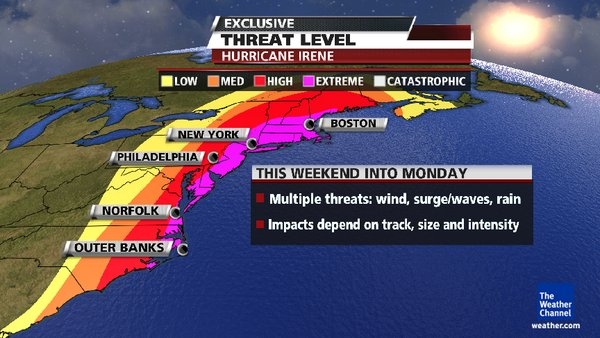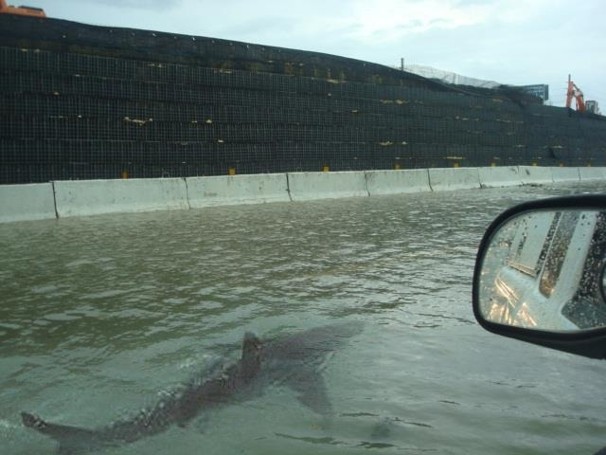Hurricane Watch: 5 ways technology is changing natural disasters
09/02/2011
Gadgets Channel / Bullz-Eye Home
I didn’t pay much attention to hurricane Irene until early last week. That was around the time meteorologists started throwing around phrases like "obliterated" and "wiped off the map" and "storm of the century" when referring to the coastal NC town I now call home. Being from Ohio, everything I know about hurricanes is from catastrophic storms of the past. I don’t know when I’m supposed to leave town. I don’t know when I’m supposed to board up my windows.
What I do know is this: when serious outdoorsy-types decide they’re going to leave town, it’s probably best to follow suit, which is exactly what I did. My girlfriend and I fled up to Durham to stay with some friends from Friday until Saturday evening, basically when the storm would be hitting the coast hardest. I still think it was a good decision - my girlfriend gets pretty nervous around storms as it is and, frankly, I don’t want to be stuck between a river and the ocean if things went from bad to worse - but it was unnecessary. Our apartment never even lost power.
That doesn’t mean there wasn’t any damage. You can find pictures all over the web of places the storm hit particularly hard. Hundreds of thousands of people lost power. Some places in the northeast are still without power, and I don’t want to downplay that. But for me, the most interesting part of the storm wasn’t the damage, it was how technology is changing the way we engage with and experience a storm.
Preparation
As I mentioned above, I know very little about hurricanes, so my preparations were a little haphazard. I moved valuables away from the windows, took anything I didn’t want to get wet off the floor, and pulled down the storm windows. When it came to packing the car, though, I took every piece of valuable electronic equipment with me - my router, my backup drive, both computers, our digital camera, phones and phone chargers, backup batteries, etc. I was grateful to have a place to go, but for someone who can’t leave town, that’s a long list of data-storing devices to try to keep safe.
There are also some new considerations for old technologies. Do you have a landline? I don’t, which means my cell is my only option in a storm. How do I keep it charged? What about radios? I haven’t had a radio for years now, which means I go without news updates if things get really nasty. None of this stuff is really all that new but engaging with it first hand made me realize how unprepared I really was.
Sensationalized Reporting

As long as news networks are trying to make money, the news will be sensational, but technology has elevated sensationalism by giving us easy access to information. When anyone with an internet connection and a mild interest in the weather can track a storm, stations like The Weather Channel have to give us something interesting, something to hook us into what the reporters are saying. Words like "obliterated" show up to drive panic, keep people engaged with what’s happening, and hopefully keep them watching. At one point on Friday night, a Weather Channel reporter claimed this would be the "storm of the century." A category three hurricane is the storm of the century? Nice thought, but I doubt it.
Official Overestimation
The Weather Channel wasn’t the only source of information that was blowing things out of proportion. Political offices were warning civilians against worst-case scenarios rather than most-probable scenarios. It’s definitely good to be prepared, but I know people in town who spent hundreds of dollars buying up non-perishables and boarding up windows because of official statements. They were hugely overprepared, and mostly because political officials don’t want to be wrong.
As NPR reported earlier this week, the overestimation of disaster is a result of "hindsight bias," that "looking back at the events that happened in the past, they look way more predictable than they actually were." Availability of information only makes this more of an issue. If officials make the wrong call, the public has access to incredible amounts of data. Mix that data with an outraged civilian population, a population that feels they should have been warned about a disaster and officials will most definitely be to blame. Obviously, politicians want to avoid that at all costs.
The Real News
As much as technology has helped shift the official line toward overestimation and sensationalism, it has also enabled us to get real local news. As Irene started to pick up along the NC coast, a Facebook event called the Hurricane Communication Circle popped up. The event took data and images shared by the thousands of people "attending" the event to provide developments about the storm an a nearly minute-by-minute basis. There were shots from around town, reports of transformer fires, road closings, floodings, and power outages. It was better information than I could get from any other news location, all on a simple Facebook page.
The Fake News
 No Facebook group would be complete without a few trolls and pranksters. The same Facebook group that was providing me with images and news updates also included some fakes, like the picture at right. As Irene approached New York, residents posted images from "The Day After Tomorrow" on Twitter.
No Facebook group would be complete without a few trolls and pranksters. The same Facebook group that was providing me with images and news updates also included some fakes, like the picture at right. As Irene approached New York, residents posted images from "The Day After Tomorrow" on Twitter.
Most of the fake news is easy to spot, but some of it isn’t. Take, for instance, the photo that was supposedly Irene approaching North Carolina. It was actually a storm in Pensacola, Florida taken weeks before Irene arrived. Then there was the photo of floodwater pouring into the subway at Times Square. It was an old photo, but got attributed to Irene and viewed by thousands. The disconcerting part is that uncovering fakes becomes almost more important and newsworthy than the news itself. As one social media consultant from New York put things, "I know this is NYC but I'm kind of over the sarcasm. There is still flooding all over the city and long island was hit really hard."
In some ways, technology has made weathering a storm much easier. We have more access to more information than ever before. That mountain of data continues to work against us, though. It can be nearly impossible to decipher what’s real and what’s fake, what’s old and what’s new, and what, if any of it, is worth getting worked up over.
You can follow us on Twitter and Facebook for content updates. Also, sign up for our email list for weekly updates and check us out on Google+ as well.









